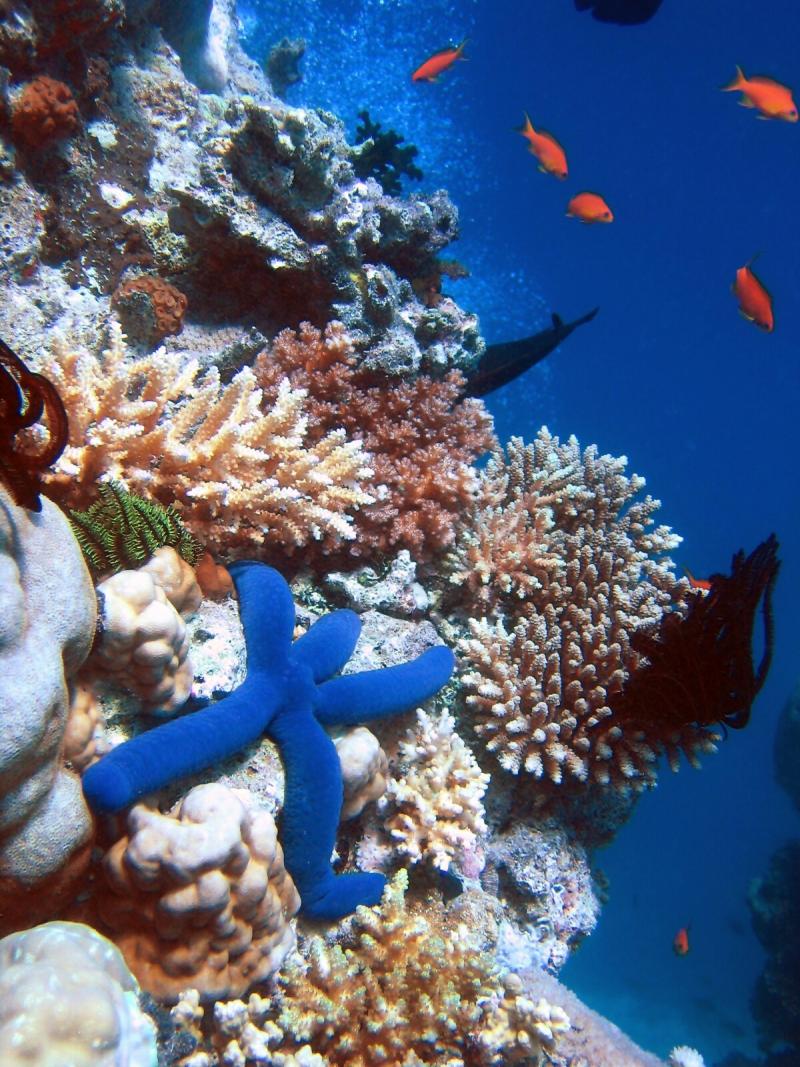My visit to Heron Island revealed that evolution does not always generate elegant or even obviously efficient solutions. Instead, the island ecosystem, with its bird-killing trees and turtle-gobbling sharks, is built on what appear to be profligately inefficient exploitation of the rich resources generated by the reef. To me, the coral reef, with its myriad species and complex food webs, seems fully-realized and enduring, while the relatively few island species form an ecosystem that seems more tenuous and vulnerable–just one strong typhoon from being entirely erased.
its myriad species and complex food webs, seems fully-realized and enduring, while the relatively few island species form an ecosystem that seems more tenuous and vulnerable–just one strong typhoon from being entirely erased.
It turns out, however, that the greatest danger to the birds, trees, and turtles of Heron Island may not come from above, as it were, but from below. Ecologists warn us that coral reefs, despite their stupendous species richness, are among the most vulnerable ecosystems on the planet. And, while coral reefs have survived and evolved for millions of years, the rate of current climate changes being driven by human activities is striking coral reefs where they are most vulnerable–by rapidly affecting the temperature and depth of the ocean, and the chemistry of ocean waters.
The success of coral reefs rests on the partnership of two tiny organisms neither of which can survive alone, but that together, can gradually build the largest and most productive living structures on Earth. Coral, though looks like underwater trees and shrubs, is actually an agglomeration of billions of individual animals that adhere to each other by the sticky shells they secrete. You can picture it as a vast Lego structure, with a tiny animal–a coral polyp–living inside each block. Living in each polyp are tiny photosynthetic algae called zooxanthellae. These are like tiny solar panels, but instead of turning sunlight into electricity, they use photosynthesis to make sugars that feed the coral polyps. The energy harvested by the zooxanthellae allows the polyps to multiply, the waste from the polyps feed a multitude of bacteria, which are in turn eaten by single-celled eukaryotes, sea stars, and anemones, which support fish, and so on, until you arrive at the great spectacle that is a fully mature coral reef ecosystem. Even the birds and trees of Heron Island ultimately depend on those little solar-paneled Lego houses.
How will Heron Island fare as the climate continues to change? Ecologists say, probably not so well. The foundational partnership between coral and zooanthellae is unfortunately extremely sensitive to the very factors climate change is affecting. First, warm water temperatures cause coral polyps to expel their algal partners. After a brief warming, the zooxanthellae come back when the stress diminishes. But temperature rises that last too long, or are accompanied by other stresses like pollution, result in permanent expulsion. When this happens in what are known as "bleaching events", the coral turns white (it is different species of zooxanthellae that provide corals with their many colors) and, eventually, the polyps die. As ocean temperatures rise, coral bleaching events are likely to grow more extensive and permanent.
Second, ocean acidification–the gradual drop in pH that is occurring as ocean surface waters absorb much of the atmosphere's rising carbon dioxide content–affects polyps’ ability to secrete their calciferous shells. Scientists fear that because corals grow more slowly and are more fragile, they will erode faster than they can regenerate, leading to an inexorable decline.
Finally, remember that the entire system rests on the prodigious ability of those tiny zooanthellae to photosynthesize, or turn light into sugar. No light, no sugar. As sea level rises, corals will find themselves under more and more water, and less light will reach them. Productivity will fall accordingly.
Life is resilient. Evolution provides a lot of tools for adaptation. But organisms can only change so much, so fast. The fossil record provides thousands of examples of organisms that could not adapt to abruptly changing conditions and became extinct. The rates of change that the Great Barrier Reef is experiencing–in temperature, in acidification and in water depth–are very rapid by any historical measure, and the entire system could collapse. Especially when you consider that climate change adds additional stress to systems that face other challenges such as fertilizer run-off, pollution, and over-fishing. Overcoming a multitude of pressures seriously increases the evolutionary “degree of difficulty.”
The Great Barrier Reef is 1400 miles (2,300 kilometers) long–about the same length as the entire west coast of the United States. It is large enough to be seen from space. It is wonderfully, extravagantly, beautiful. And it is terribly vulnerable. The birds, and trees, and turtles of island like Heron Island will also be lost if the coral succumbs to the stresses of climate change. Life–and evolution - will go on. Some organisms will survive, even thrive, and gradually evolve to exploit the new conditions. Chances are, for example, that new ecosystem will include a lot of bacteria and jellyfish. We can be sure that nothing as glorious, or as productive, from a human point of view, will evolve to fill the changed environment within our lifetimes or that of our children’s children. That’s why it’s so worth doing what we can to slow the pace of climate change–it is not too late to save the reefs.

